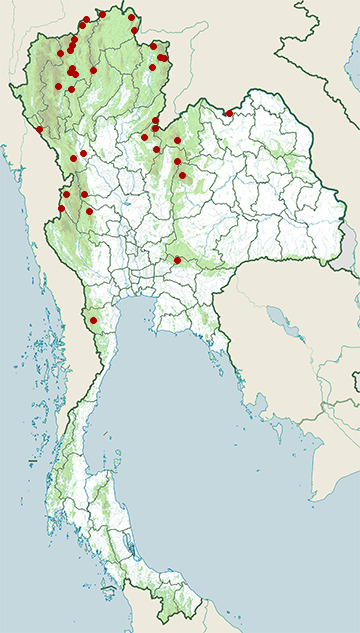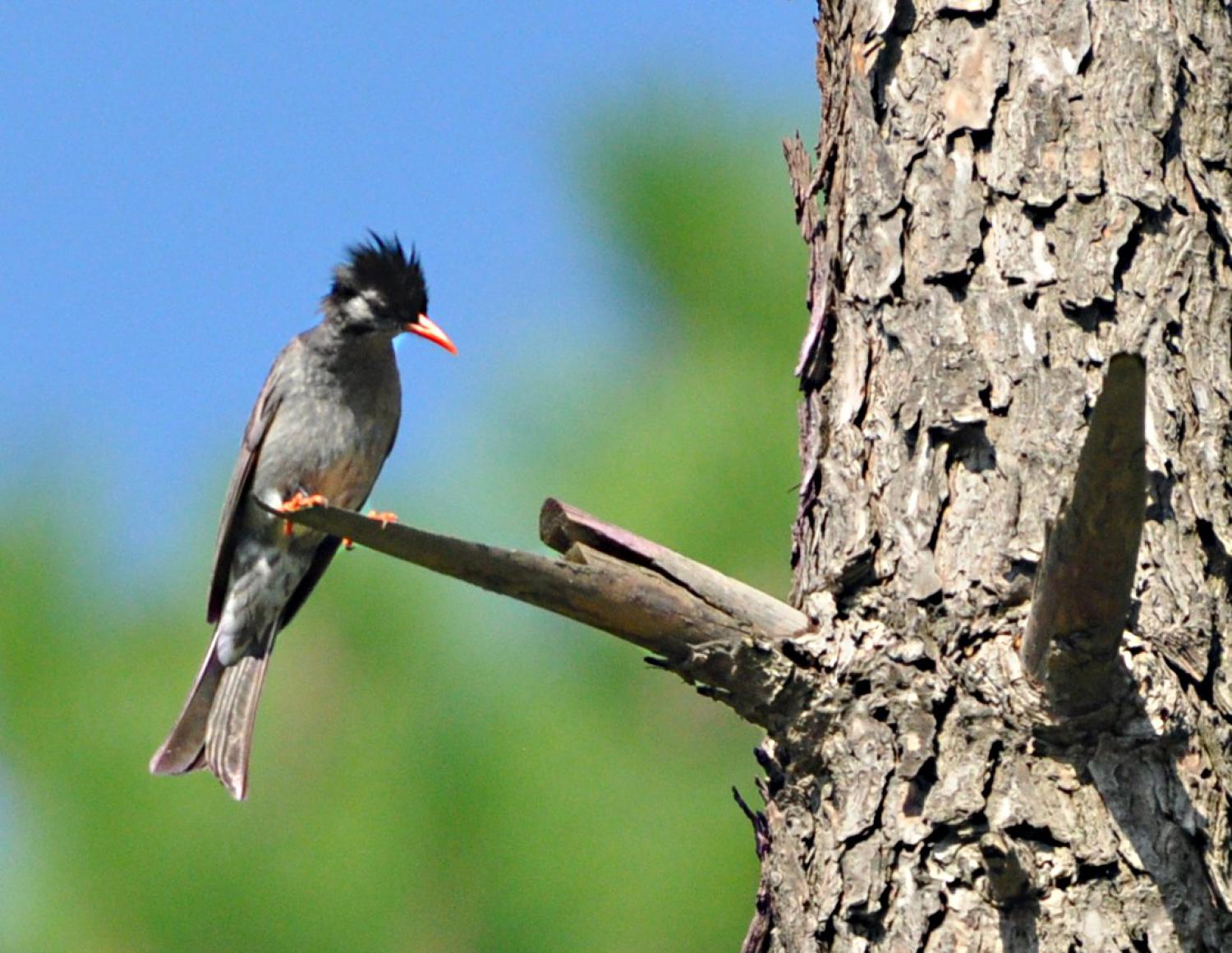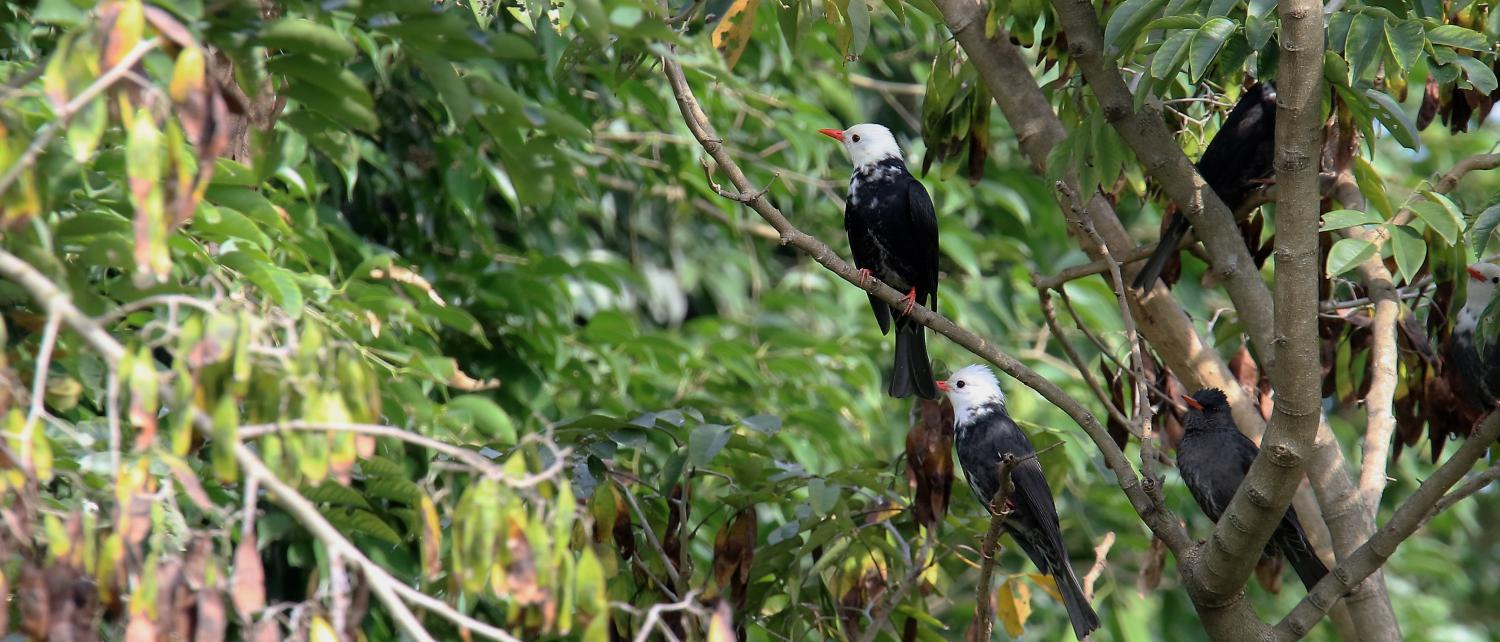Species of Thailand
Black bulbul
Hypsipetes leucocephalus
Johann Friedrich Gmelin, 1789
In Thai: นกปรอดดำ
The black bulbul (Hypsipetes leucocephalus), also known as the Himalayan black bulbul or Asian black bulbul, is a member of the bulbul family of passerine birds. It is found in southern Asia from India east to southern China. It is the type species of the genus Hypsipetes, established by Nicholas Aylward Vigors in the early 1830s. There are a number of subspecies, mostly varying in the shade of the body plumage which ranges from grey to black, and some also occur in white-headed morphs, as also suggested by its specific epithet leucocephalus, literally "white head". The legs and bill are always rich orange-red.
Taxonomy and systematics
The black bulbul was originally described in the genus Turdus and has also been considered as either conspecific with or as subspecies of the Malagasy bulbul. The common name 'black bulbul' is also used as an alternate name by the Malagasy bulbul. Formerly, the square-tailed bulbul was also classified as two subspecies of the black bulbul.
Subspecies
Ten subspecies are currently recognized, although the reproductive isolation mechanisms such as vocalization and geographic distributions of these populations still remain to be studied:
- H. l. psaroides - Vigors, 1831: Originally described as a separate species. Found along the Himalayas from the Kunar Valley (north-eastern Afghanistan) and northern Pakistan through Arunachal Pradesh (northern India) and the central Himalayas to north-western Myanmar
- Assam black bulbul (H. l. nigrescens) - Baker, ECS, 1917: Found in Assam and Manipur (north-eastern India), and the Chin Hills (western Myanmar)
- Burmese black bulbul (H. l. concolor) - Blyth, 1849: Originally described as a separate species. Found from eastern Myanmar and southern Yunnan (southern China) through Indochina
- H. l. ambiens - (Mayr, 1942): Found in north-eastern Myanmar and western Yunnan (southern China)
- H. l. sinensis - (La Touche, 1922): Found in northern Yunnan (southern China)
- H. l. stresemanni - (Mayr, 1942): Members of this race have white heads. Found in central Yunnan (southern China)
- H. l. leucothorax - (Mayr, 1942): Members of this race have white heads. Found in central China
- H. l. leucocephalus - (Gmelin, JF, 1789): Members of this race have white heads. Found in south-eastern China
- H. l. nigerrimus - (Gould, 1863): Originally described as a separate species. Found in Taiwan
- H. l. perniger - R. Swinhoe, 1870: Originally described as a separate species. Found on Hainan (off south-eastern China)
Description
The black bulbul is 24 – 25 cm in length, with a long tail. The body plumage ranges from slate grey to shimmering black, depending on the race. The beak, legs, and feet are all orange and the head has a black fluffy crest. Sexes are similar in plumage, but young birds lack the crest, have whitish underparts with a grey breast band, and have a brown tint to the upperparts. They have a black streak behind the eye and on the ear coverts.
Vocalisations
They can be quite noisy, making various loud cheeping, mewing and grating calls. The Himalayan form has been reported to make a call resembling a goat kid, throwing back its neck when calling.
Distribution and habitat
This bulbul is found in broad-leaved forests, cultivation and gardens mainly in hilly areas, but Himalayan populations are known to sometimes descend into the adjoining plains in winter.
Breeding
It builds its nest in a tree or bush; the nest is a cup placed in a fork and made from grasses, dry leaves, mosses, lichens and cobwebs. The lining is made up of ferns, rootlets and other soft material. Both sexes participate in nest construction. Two or three eggs form the usual clutch.
Food and feeding
Black bulbuls feed mainly on seeds and insects, and they are often seen in small groups, either roosting or flying about in search of food. They are particularly fond of berries. They are known to feed on a wide range of berries including Celtis, Rosa, Melia and Ehretia in the Himalayas. They feed on the nectar of Salmalia, Erythrina, Rhododendron and other species. They make aerial sallies for insects.
This article uses material from Wikipedia released under the Creative Commons Attribution-Share-Alike Licence 3.0. Eventual photos shown in this page may or may not be from Wikipedia, please see the license details for photos in photo by-lines.
Category / Seasonal Status
Wiki listed status (concerning Thai population): Resident and winter visitor
BCST Category: Recorded in an apparently wild state within the last 50 years
BCST Seasonal statuses:
- Resident or presumed resident
- Non-breeding visitor
Scientific classification
- Kingdom
- Animalia
- Phylum
- Chordata
- Class
- Aves
- Order
- Passeriformes
- Family
- Pycnonotidae
- Genus
- Hypsipetes
- Species
- Hypsipetes leucocephalus
Common names
- Thai: นกปรอดดำ
Conservation status

Least Concern (IUCN3.1)
Photos
Please help us review the bird photos if wrong ones are used. We can be reached via our contact us page.
Range Map

- Chae Son National Park
- Chat Trakan Waterfall National Park
- Chiang Dao District, Chiang Mai
- Chiang Dao Wildlife Sanctuary
- Chiang Khong District, Chiang Rai
- Doi Inthanon National Park
- Doi Lang
- Doi Pha Hom Pok National Park
- Doi Phu Kha National Park
- Doi Suthep - Pui National Park
- Huai Kha Khaeng Wildlife Sanctuary
- Huai Nam Dang National Park
- Kaeng Krachan National Park
- Khao Yai National Park
- Khun Nan National Park
- Mae Fa Luang District, Chiang Rai
- Mae Moei National Park
- Mae Rim District, Chiang Mai
- Mae Wong National Park
- Mueang Chiang Mai District, Chiang Mai
- Mueang Nong Khai District, Nong Khai
- Mueang Tak District, Tak
- Nam Nao National Park
- Pa Sang District, Lamphun
- Pha Daeng National Park
- Phu Chi Fa Forest Park
- Phu Hin Rong Kla National Park
- Phu Khiao Wildlife Sanctuary
- Phu Luang Wildlife Sanctuary
- Phu Soi Dao National Park
- Phu Suan Sai National Park
- Taksin Maharat National Park
- Tham Sakoen National Park
- Thung Chang District, Nan
- Thung Yai Naresuan Wildlife Sanctuary
- Umphang Wildlife Sanctuary

